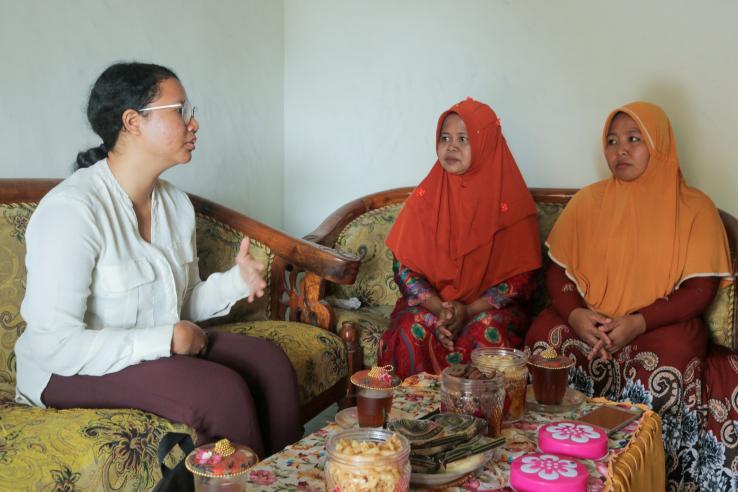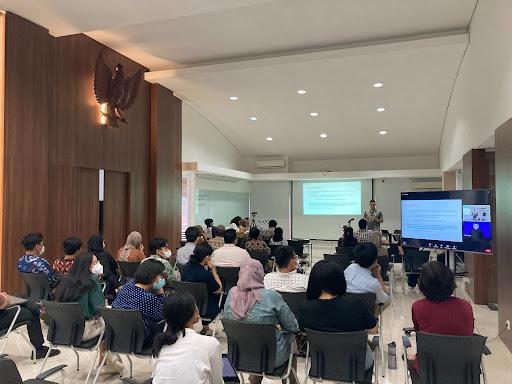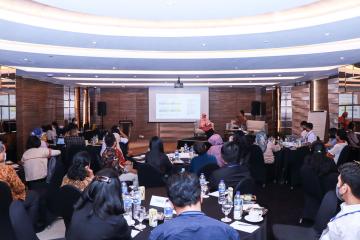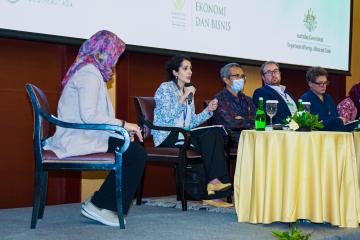
Understanding the hidden factors influencing child marriage: Lessons from an impact evaluation

Photo: Ittaqi Fawzia | J-PAL
Globally, 12 million girls are married before turning eighteen. In low-income countries, this number doubles with 40 percent married before eighteen years old and 12 percent married before fifteen years old. In the case of Indonesia, child marriage remains a pressing concern. Despite the decline in child marriage incidences from 14.7 percent in 2008 to 10.8 percent in 2019, the rate of child marriage in 22 provinces in Indonesia is still high, surpassing the national average. As a result, the government has set a target to reduce child marriage by 8.74 percent nationwide by 2024.
In an effort to reduce child marriage, the Indonesian government has implemented various programs utilizing video-based information campaigns to drive behavioral change. As an example, The National Population and Family Planning Board collaborated with Fatayat Nadhlatul Ulama to make a short video campaign, titled Kecele, informing viewers of the benefits of delaying marriage at an early age. Another example is a short video by Gunung Kidul District Office, sharing a girl's experience of child marriage and highlighting the crucial role of parents and religious teachings in preventing child marriage. Despite the widespread use of video campaigns, there is not rigorous evidence on their effectiveness.
Understanding the impact of educational entertainment among child marriage actors: Findings and insights from a rigorous evidence
In March 2023, J-PAL Southeast Asia (SEA) hosted a public event to disseminate evidence on the impact of educational entertainment in changing the perceptions and attitudes of parents and teenagers on child marriage. In this randomized evaluation, Milda Irhamni (former Associate Director of Research, J-PAL SEA) and coauthor J-PAL affiliated researcher Gumilang Aryo Sahadewo (Universitas Gadjah Mada University) designed a short movie that portrays the reality of child marriage in Central and East Java, Indonesia.
Using a narrated story, researchers tailored the intervention by incorporating messages on the costs of child marriage, benefits of delaying child marriage, and alternative religious views to tackle social bias and societal perceptions associated with child marriage. Findings from the randomized evaluation suggested that viewing the narrated short movie had an impact on the overall perceptions of child marriage, affecting the perceived risks associated with child marriage and the benefits of delaying such practices among girl respondents.
During the event, participants had the opportunity to discuss and exchange knowledge about the issue at hand. Additionally, Santi Kusumaningrum (Director of Center on Child Protection and Wellbeing), was invited as a panelist to share her expert insights on the underlying factors contributing to the prevalence of child marriage that remain unexplored. Below are the key takeaways from the discussion that took place at the event in regard to the study findings:
1. Children lacking socially and morally acceptable avenues to express their opinions and desires may be more likely to enter into early marriage.
The absence of safe spaces where children can openly discuss intimacy and relationships can play a role in influencing their decision to marry at an early age. Without adequate platforms to start an open and honest dialogue, children may lack the necessary guidance and information to make informed choices about their relationships. Additionally, with social judgments and restrictions on children's expressions of intimacy, it can be challenging to justify and inform children that the benefits of delaying child marriage would outweigh the risk related to the practice.
In the study sample, 2 percent of respondents reported that they have siblings who married before the age of eighteen, highlighting the proximity of child marriage incidence to children’s daily lives. Recognizing this, the government is taking steps by developing a national plan aimed at enhancing the role of families and communities to create a supportive environment and emphasizing the importance of children’s self-expression.

Photo credit: J-PAL SEA
2. Children need support to understand the implications of their choices.
Decision-making involves a combination of intuitive thinking, logical reasoning, confidence, and the assessment of short-term and long-term risks. While children and teenagers have the right to make their own choices, they often find themselves in intricate circumstances that make it challenging for them to make informed decisions. When it comes to deciding whether or not to marry at an early age, children may believe that they have a full understanding of all the risks involved when, in reality, recognizing the long-term implications can be challenging
During the exploratory phase, the study found that in Indonesia, decisions on child marriage are often the result of a bargaining process between parents and children. Children in Indonesia often request permission from their parents to marry at an early age, compared to other South Asia countries where parents' decisions are often the sole driving factor. Children who choose to marry young tend to prioritize the short-term benefits, disregarding the potential long-term consequences such as lower educational attainment and maternal health risks. Therefore, more research is needed to direct our attention to the children’s decision-making process.
3. We need more research to understand who should be responsible for making decisions for children.
Another aspect to consider is how to determine the "right" person to make decisions for children. The study finds that among girl respondents, the majority perceived that parents have the main authority in marriage decisions. However, about a third of the respondents perceive that they themselves have a right over child marriage decisions. The question arises as to whether parents should be responsible for making sound decisions for their children, particularly regarding long-term commitments such as marriage.
Apart from parents, children often rely on other people’s opinions and are easily affected by their environment, including social media. Understanding the role of peers can provide insights into how social interactions and group dynamics can shape children's choices which potentially affect the likelihood to delay marriage.
4. Researchers need to take into account ethical considerations when designing interventions related to children's aspirations.
In all research involving human subjects, respecting ethical principles must always be the number one priority. When designing interventions aimed at inspiring children’s aspirations, it is important to ensure that the intervention does not cause harm to the children involved. For example, researchers have an ethical obligation to avoid portraying married children as being inherently better or more successful than their unmarried counterparts. Rather, messages need to have positive implications, such as encouraging children to explore their full potential and complete their education. By adhering to ethical principles, researchers can prioritize the well-being and protect the best interests of children.
Way forward
The public dissemination event provided insights on the influential factors behind child marriage decisions. However, these warrant further examination and open up new possibilities for future research. Given the complexity of child marriage, it is essential to delve deeper by examining the issue beyond economic factors, namely socio-cultural and religious perspectives.
Furthermore, as the findings suggested that short movies have the potential to change perceptions related to child marriage, a next step is to understand whether this change will translate into a reduction in child marriage rates. Additionally, further research is needed to evaluate the impact of interventions targeting parents and boys, who also play roles in the decision to marry early.
Through evidence generation, J-PAL SEA will continue to support the Government of Indonesia’s effort to reduce the prevalence of child marriage by addressing factors that contribute to the practice.
Related Content

Overcoming barriers to women’s adoption of digital financial services in Indonesia

Accelerating financial inclusion in Indonesia through innovations in digital financial services: Early learnings from exploratory and pilot studies


